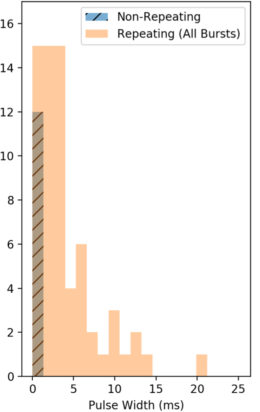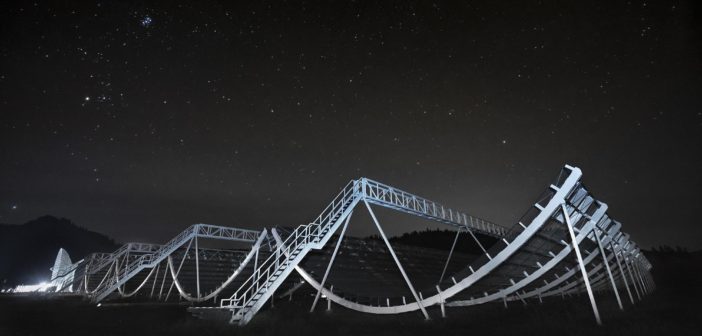In October of 2018, we wrote about a new project to study fast radio bursts (FRBs) — brief, energetic flashes of light from beyond our galaxy. At the time, we knew of about 30 FRB sources; the new project by the Canadian Hydrogen Intensity Mapping Experiment (CHIME) telescope in British Columbia promised to dramatically increase that number.
Now, a year and a half later, we can see the impressive progress made: CHIME has already detected around 700 bursts from FRB sources! Included among those is the collaboration’s latest announcement: nine new repeating sources.A Question of Repetition
FRBs were first discovered more than a decade ago. These bright, short (around a millisecond) flashes of radio emission are a million times brighter than the brightest pulses from galactic pulsars, and they carry the signature of being produced at a great distance — something that has been further confirmed by the localization of several FRBs to faraway galaxies.
Despite all we’ve learned about FRBs, we still don’t know how they’re produced — though the list of theories has now grown large enough that there’s actually a living catalog of them. One particular puzzlement is that some FRBs have been observed to repeat, whereas others have produced only one detected flash.

Burst profiles for some of the new fast radio bursts detected by CHIME. Click to enlarge. [Fonseca et al. 2020]
Clues from New Flashes
To answer these questions, our best bet is to find enough FRBs to be able to make statistical inferences — and CHIME is helping to build a large sample. In a new publication led by Emmanuel Fonseca (McGill University, Canada), the CHIME collaboration presents a collection of bursts from nine new repeating FRB sources, bringing the total number of known repeaters to 20.
What does this new sample tell us? So far, it’s confirmed previous assessments of the two populations of repeaters and non-repeaters:

Pulse widths for repeating (orange) vs. nonrepeating (blue) fast radio bursts show a distinct difference between the two populations. [Adapted from Fonseca et al. 2020]
- The dispersion measures — a measure of the matter the signals travel through to reach us — for repeaters have the same distribution as those for non-repeaters, suggesting the two populations originate in similar local environments and have similar distributions in space.
- The pulse widths are larger for repeaters than for non-repeaters, meaning that repeating sources have slightly longer-duration bursts. This may point to different emission mechanisms for the two types of bursts.
- The Faraday rotation measures — a measure of the magnetized environment around the burst source — were obtained for two of the new repeaters, and they are lower than the surprisingly high rotation measure of FRB 121102, the first known repeater. We don’t have enough measurements to tell for certain yet, but it’s starting to look like FRB 121102 is an anomaly, and both repeaters and non-repeaters typically originate from more modestly magnetized environments.
We still have a lot to figure out, but as we build up FRB statistics with samples like these, we can start to rule out some of the many origin theories for fast radio bursts. It’s exciting to watch this field as it rapidly evolves!
Citation
“Nine New Repeating Fast Radio Burst Sources from CHIME/FRB,” E. Fonseca et al 2020 ApJL 891 L6. doi:10.3847/2041-8213/ab7208



11 Comments
Pingback: SPACE TODAY
Pingback: Even More Repeating Fast Radio Bursts Discovered - Worldika - New Platform For Explore World
Pingback: Even More Repeating Fast Radio Bursts Discovered – Dinezh.com
Pingback: CHIME Detecta Mais FRBs Repetidas | Mestre Jedi
Pingback: CHIME detecta más estallidos rápidos en radio que se repiten – Observatori Astronòmic
Pingback: CHIME detecta más estallidos rápidos en radio que se repiten « SEDA / LIADA - RedLIADA - Cursos LIADA - Cielo del Mes - Fenómenos Astronómicos - RELEA
Pingback: CHIME detecta más estallidos rápidos en radio que se repiten « Sección de Astrofísica de la LIADA
Pingback: Eerie Radio Signals Coming From Space Are Some of the Biggest Mysteries Out There – worldnewsas.com
Pingback: An Update on Fast Radio Bursts: New Discovery in Our Own Galaxy
Pingback: Have We Found the Closest Extragalactic Fast Radio Burst? | astrobites
Pingback: Have We Found the Closest Extragalactic Fast Radio Burst?